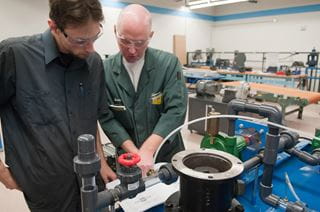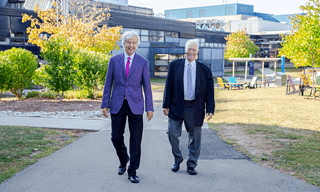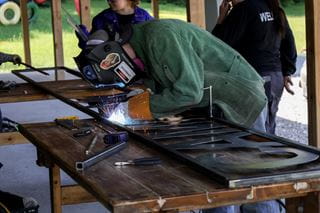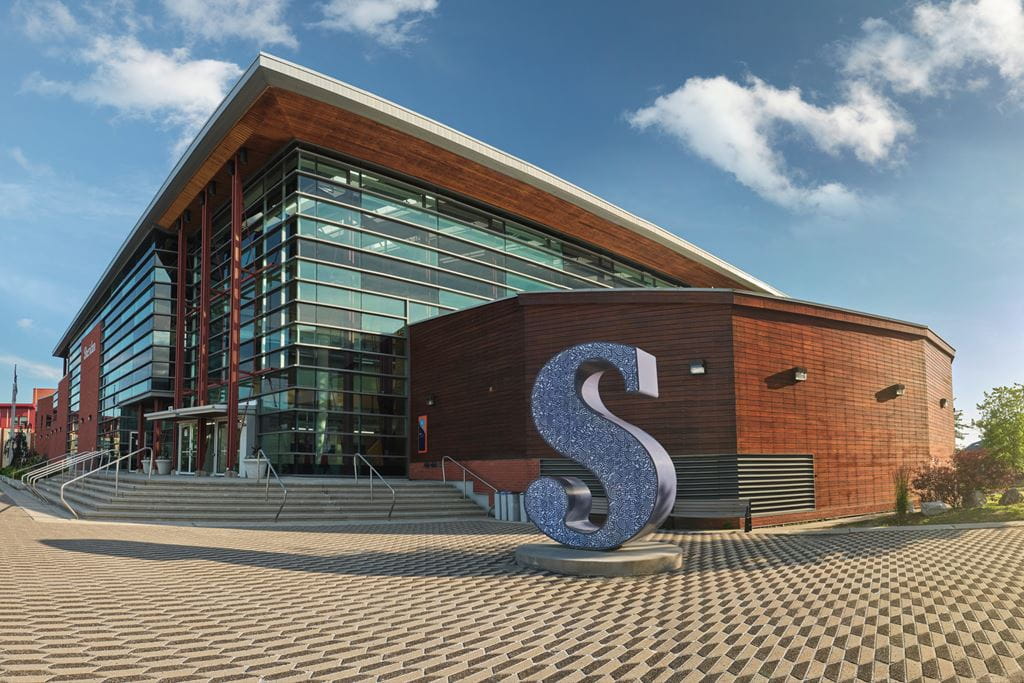
How can educators use generative AI in the classroom?
 by Jon Kuiperij – Nov 8, 2023
by Jon Kuiperij – Nov 8, 2023 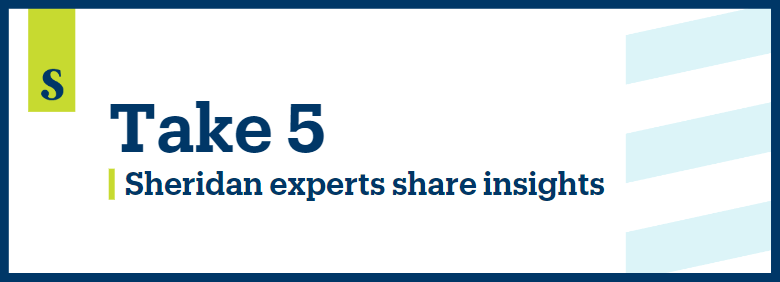 In Take 5, Sheridan's thought leaders share their expert insight on a timely and topical issue. Learn from some of our innovative leaders and change agents as they reflect on questions that are top-of-mind for the Sheridan community.
In Take 5, Sheridan's thought leaders share their expert insight on a timely and topical issue. Learn from some of our innovative leaders and change agents as they reflect on questions that are top-of-mind for the Sheridan community.
 Artificial intelligence’s use of predetermined algorithms and rules to perform preset tasks has enhanced our lives for decades, from optimizing manufacturing processes to recommending television series to providing a worthy opponent in chess. But the arrival of generative AI and its ability to create original content — including articles, images, videos, music and computer code — has many wary of its potential to disrupt the ways in which we learn, work and play.
Artificial intelligence’s use of predetermined algorithms and rules to perform preset tasks has enhanced our lives for decades, from optimizing manufacturing processes to recommending television series to providing a worthy opponent in chess. But the arrival of generative AI and its ability to create original content — including articles, images, videos, music and computer code — has many wary of its potential to disrupt the ways in which we learn, work and play.
In this edition of Take 5, Sheridan creativity and leadership professor Dr. Brandon McFarlane discusses the value of using generative AI in the classroom, how educators can think of ways to embed the technology into their teaching process and more.
1. Why is it so important for educators to use generative AI in the classroom?
This technology is going to transform industry, and rapidly so. That makes it critical to provide students with viable generative AI experiences and skills they can bring into the job market.
As an educator, I also feel it's important to model learning and failing along the way. This is a chance to show myself struggling with something new, playing with it to figure out how it works, occasionally failing with grace and learning from those mistakes. This shows students that it's OK to experiment and try new things, because that's how you come up with creative and innovative ideas.
This is a good opportunity to learn how to use something new, experiment with it and find out its capabilities. Those are skillsets that are broadly transferable to all situations, whether you're creating ideas, innovating or trying something new in your personal life. The ability to take risks, fail, and learn from those experiences is essential.
2. Why might professors and teachers be reluctant to include generative AI into curriculum?
Efficiency and productivity are huge considerations, as most professors and teachers are really pressed for time. That's why we tend to make tests and assignments we can use over and over again. Learning how to use a new technology can be a huge time commitment, so many people might not be willing to invest personal time or sacrifice other areas of their work to open up time to experiment with new technologies.
Another factor is intolerance to ambiguity and risk-taking. Generative AI is an emerging technology, so we have no idea what it's going to do in the classroom. I could come up with an assignment and try it out at home three or four times to see what happens, but generative AI's capabilities might be throttled if there's more users or a content update could change how it operates in response to a problem.
As teachers, we sometimes think that we have to be perfect... that we can't make mistakes in the classroom, or that we need to be these superhuman role models. But it doesn't always have to be that way. Sometimes we need to embrace the spirit of play and experimentation.
3. Are there any creative thinking tactics that can help educators think of ways to use such a new or foreign technology in the classroom?
The first thing I recommend doing is coming up with analogies that make the technology more familiar, which is a really common strategy in the context of innovation.
One analogy I've formed compares generative AI to a contemporary playground that allows any user to come in and choose how they'll interact with the space that day, while providing the ability to gradually increase risk and have moments of discoveries. Adopting this mindset about generative AI is helpful for embracing the classroom as a place to test yourself, try new things, and know it's OK to make mistakes.
“Just like leaf blowers that can generate noise which irritates others or can be used to blow leaves onto other people's property, generative AI can present challenges to academic integrity or be used to plagiarize or create unethical material. By anticipating the potential for unintended consequences, you can predict them and try to find a way to mitigate them in your own practice.”
Another analogy compares generative AI and leaf blowers — technologies that enable us to do tasks faster, but can also have negative or unexpected consequences that make us question if we want to use them or not. Just like leaf blowers that can generate noise which irritates others or can be used to blow leaves onto other people's property, generative AI can present challenges to academic integrity or be used to plagiarize or create unethical material. By anticipating the potential for unintended consequences, you can predict them and try to find a way to mitigate them in your own practice.
Once you've made these analogies, think about things you've wished you could do before — ideas for a class, lecture, exercise or assignment — but didn't because you didn't have the resources or the support or it wasn't feasible. Then think about things on your list that might be doable with the assistance of generative AI, and categorize those ideas by how easily or realistically you could implement them.
4. What are some specific examples of ways in which educators can integrate generative AI into their teaching?
Start with the most likely and probable ways — easy wins — that can help you get generative AI into your classroom as quickly as possible. An example of this would be asking ChatGPT to summarize an article or a reading and then have your students factcheck or proofread that summary. This is an easy assignment to create and there are many different skills learners can develop through that exercise.
A more imaginative or slightly riskier use of generative AI could be creating a client or collaborator to support students in an online class. If it's an asynchronous class, the students could use the AI as a robot that helps them learn a process or procedure or try out a strategy that was introduced in a lecture.
A more fanciful or improbable application might be writing a prompt that describes what you want to see or plans an activity, and then the AI creates a virtual world in which that takes place. That would be really exciting because you could take your class anywhere you want to go or design almost any virtual experience you want. Your imagination would become the limit of what you're able to do. Such technology is a few years away, but soon we all have access to generative virtual reality and augmenting reality, which is extraordinarily exciting for educators.
5. What are some other ways generative AI could potentially change teaching and learning in the next five years?
In higher education, we like to focus on personalized learning, which means treating every student as a full individual, learning about their goals and motivations, and trying to support them while providing them with a rewarding experience. The opposite of that approach is mass education that requires less time and resources, such as a large online class in which curriculum can be broad, repetitive, and rigid.
ChatGPT and other technologies can reconcile those opposites. Professors could build an online course that includes interactive assignments in which the AI asks students personal questions to find their goals and motivations, then makes slight adjustments to the exercise so that it's more personalized and customized. This potential is something I'm really excited about because, as much as I want to give every individual a lot of one-on-one attention, I'm not always able to do so, especially when we're working online. This technology can allow individualization to happen while using the mass education model.
“As much as I want to give every individual a lot of one-on-one attention, I'm not always able to do so, especially when we're working online. This technology can allow individualization to happen while using the mass education model.”
I'm also hopeful that generative AI will be integrated into things like augmented reality, virtual reality and even projection technology so we're able to transform our classrooms into experiences and dynamic spaces that are constantly changing based on the imaginations of students and professors. Early prototypes will be really rough, but they will gradually improve and I think we'll soon be able to do some incredible things that help students build skills and confidence before going out in the real world. Some of these simulation technologies already exist, but generative AI can help professors create even more dynamic experiences for their students in ways that are more cost-effective and accessible.
Finally, I think the idea of grades and ranking students based upon their level of performance is a little bit arbitrary and becoming a bit dated. ChatGPT and other technologies could create the opportunity to eliminate grades and focus more on the experience, rewarding participation, experimentation, play, and creativity. If we can’t use essays anymore as an assessment tool and know that everything will be fundamentally collaborative, maybe we can move to a system that is more pass-fail and assesses how much people benefit from a program rather than how much they are able to perform a capability.
Dr. Brandon McFarlane has taught in Sheridan's Pilon School of Business since 2022 as a Professor of Creativity and Leadership. Prior to coming to Sheridan in 2015, he spent seven years as an adjunct professor at the University of Toronto, where he designed and instructed courses for the Department of English, Department of Geography and Planning, and Canadian Studies program. Brandon leads the international Creative Humanities movement, which is unlocking the creative and innovation potential of the arts and humanities. He has led grant-funded projects that have applied Creative Humanities innovation processes to facilitate transformative change in the creative and social sectors through partnerships with municipal governments and not-for-profits. An in-demand thought leader, Brandon has delivered keynote addresses and workshops at post-secondary institutions in North America and Europe on the future of higher education. He has won numerous awards for teaching, research, and leadership excellence.
Interested in connecting with Dr. Brandon McFarlane or another Sheridan expert? Please email communications@sheridancollege.ca.
The interview has been edited for length and clarity.
Media Contact
For media inquiries, contact Sheridan’s Communications and Public Relations team.

